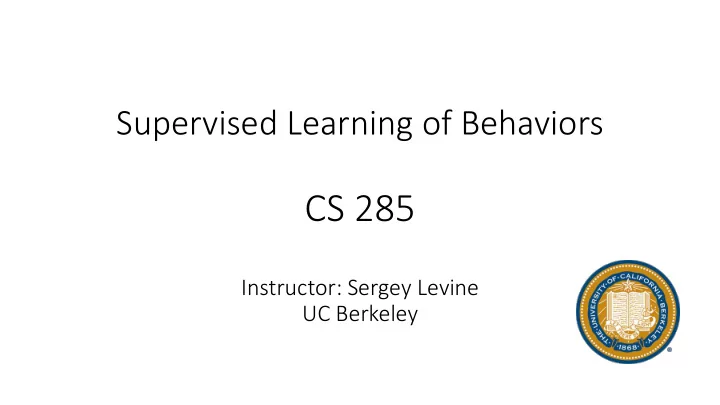

Supervised Learning of Behaviors CS 285 Instructor: Sergey Levine UC Berkeley
Terminology & notation 1. run away 2. ignore 3. pet
Terminology & notation 1. run away 2. ignore 3. pet
Aside: notation управление Lev Pontryagin Richard Bellman
Imitation Learning supervised training learning data behavioral cloning Images: Bojarski et al. ‘16, NVIDIA
The original deep imitation learning system ALVINN: A utonomous L and V ehicle I n a N eural N etwork 1989
No! Does it work?
Does it work? Yes! Video: Bojarski et al. ‘16, NVIDIA
Why did that work? Bojarski et al. ‘16, NVIDIA
Can we make it work more often? cost stability (more on this later)
Can we make it work more often?
Can we make it work more often? DAgger : D ataset A ggregation Ross et al. ‘11
DAgger Example Ross et al. ‘11
What’s the problem? Ross et al. ‘11
Deep imitation learning in practice
Can we make it work without more data? • DAgger addresses the problem of distributional “drift” • What if our model is so good that it doesn’t drift? • Need to mimic expert behavior very accurately • But don’t overfit!
Why might we fail to fit the expert? 1. Non-Markovian behavior 2. Multimodal behavior behavior depends only behavior depends on on current observation all past observations If we see the same thing Often very unnatural for twice, we do the same thing twice, regardless of what human demonstrators happened before
How can we use the whole history? variable number of frames, too many weights
How can we use the whole history? shared weights RNN state RNN state RNN state Typically, LSTM cells work better here
Aside: why might this work poorly? “causal confusion” see: de Haan et al., “Causal Confusion in Imitation Learning” Question 1: Does including history mitigate causal confusion? Question 2: Can DAgger mitigate causal confusion?
Why might we fail to fit the expert? 1. Non-Markovian behavior 1. Output mixture of 2. Multimodal behavior Gaussians 2. Latent variable models 3. Autoregressive discretization
Why might we fail to fit the expert? 1. Output mixture of Gaussians 2. Latent variable models 3. Autoregressive discretization
Why might we fail to fit the expert? 1. Output mixture of Gaussians 2. Latent variable models 3. Autoregressive discretization Look up some of these: • Conditional variational autoencoder • Normalizing flow/realNVP • Stein variational gradient descent
Why might we fail to fit the expert? dim 2 discrete value sampling 1. Output mixture of Gaussians discrete dim 1 2. Latent variable models (discretized) distribution sampling value over dimension 1 only 3. Autoregressive discretization
Imitation learning: recap supervised training learning data • Often (but not always) insufficient by itself • Distribution mismatch problem • Sometimes works well • Hacks (e.g. left/right images) • Samples from a stable trajectory distribution • Add more on-policy data, e.g. using Dagger • Better models that fit more accurately
A case study: trail following from human demonstration data
Case study 1: trail following as classification
Cost functions, reward functions, and a bit of theory
Imitation learning: what’s the problem? • Humans need to provide data, which is typically finite • Deep learning works best when data is plentiful • Humans are not good at providing some kinds of actions • Humans can learn autonomously; can our machines do the same? • Unlimited data from own experience • Continuous self-improvement
Terminology & notation 1. run away 2. ignore 3. pet
Aside: notation Lev Pontryagin Richard Bellman
Cost functions, reward functions, and a bit of theory
A cost function for imitation? supervised training learning data Ross et al. ‘11
Some analysis
More general analysis For more analysis, see Ross et al. “A Reduction of Imitation Learning and Structured Prediction to No - Regret Online Learning”
More general analysis For more analysis, see Ross et al. “A Reduction of Imitation Learning and Structured Prediction to No - Regret Online Learning”
Another way to imitate
Another imitation idea
Goal-conditioned behavioral cloning
1. Collect data 2. Train goal conditioned policy
3. Reach goals
Going beyond just imitation? ➢ Start with a random policy ➢ Collect data with random goals ➢ Treat this data as “demonstrations” for the goals that were reached ➢ Use this to improve the policy ➢ Repeat
Recommend
More recommend